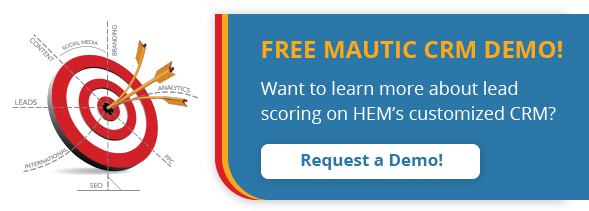
How can you tell when a prospective student is seriously interested in your school? How do you know when to pick up the phone and give them a call instead of an email? And how do you make sure you don’t miss out on the most qualified, desirable applicants?
Lead scoring involves assigning a numeric value to the attributes and actions of your prospective students to determine their interest and suitability for your programs. An increasingly popular marketing and sales process, it can be extremely valuable to schools looking to manage their resources more effectively, prioritize high potential leads, and better determine when and how to follow-up with prospects.
Read on to find out how you can get started.
Benefits of Student Lead Scoring
As your school develops and expands its digital marketing efforts, you should eventually start seeing real results with dramatic increases in the amount of inquiries you receive from prospective students. While this is undoubtedly a good thing, it sometimes takes admissions teams by surprise, with many finding their resources stretched.
In this situation, lead scoring can be a valuable tool, helping schools to better distinguish prospective students who are likely to follow through to application from those with a more casual interest, and allocate their resources accordingly, prioritizing high value leads first and ensuring they are followed up with more quickly.
However, lead scoring is about more than just time management. Often, schools can misjudge the level of interest a prospective student has at different points in the decision-making process. For instance, a prospect in the early stages of their research might sign up for a newsletter to find out more, only to be bombarded with overwhelming contact urging them to make an application.
Another prospect might reach the point where they are seriously interested in applying, but doesn’t receive the level of personalized attention they expect from the school and drops their interest. A good scoring system can help your recruitment team to gauge exactly where in the enrollment journey each individual lead is, allowing you to tailor your follow-up contact accordingly.
Lead scoring can also be used to test assumptions about your target personas and their behaviours, helping your team work towards improving their accuracy while also creating a ‘common language’ of sorts for discussing and evaluating the effectiveness of your process.
Creating the Proper Infrastructure for Student Lead Scoring
Before you can set up a lead scoring system, you need to ensure that your school has the right infrastructure. This means having some form of marketing automation or Customer Relationship Management (CRM) system in place. These platforms allow you to easily organize and manage your contact with leads, and to automate certain marketing and sales processes and tasks for more efficiency. Each platform will have its own unique lead scoring system.
Example: HubSpot allows you to create customized lead scoring attributes for students.
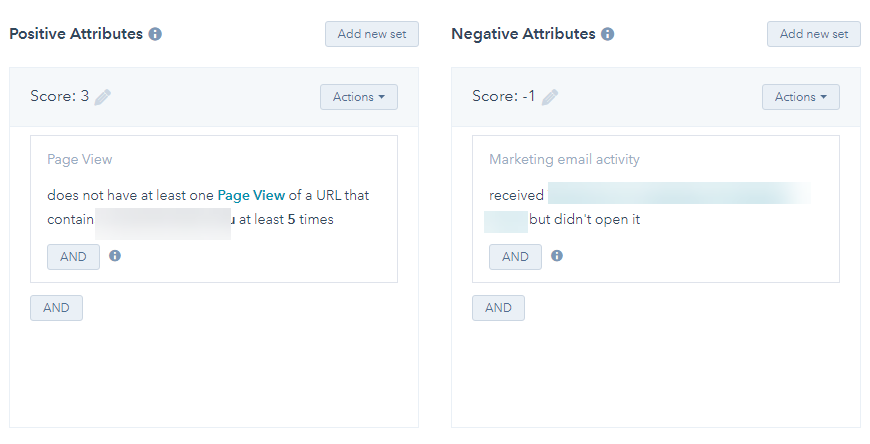
Example: HEM’s customized Mautic CRM makes it easy for schools to monitor lead attributes, activity, and path to conversion. In each contact’s profile, you can see a detailed history of their engagement with your school, what stage they’re at in the admissions journey, and of course, their lead score.

For the purposes of lead scoring, it’s preferable to look for a system that offers as many lead intelligence features as possible, as you will want to be able to track actions like page views, social media, and email engagement.
Once you have a CRM system in place, your school should look to optimize their landing pages to get as much information as possible to aid their scoring process. This means that all inquiry forms, download and mailing list sign-ups, and any other tools you have for capturing data from leads need to be as detailed as they can be, without being overwhelming or overly complicated for users.
Example: This inquiry form for prospective MBA students from London Business School aims to capture a lot of actionable information, including their country of residence, company name, and job title. Note that you can also choose to autofill the form using LinkedIn, which would automatically pull in your profile information from the social media site.
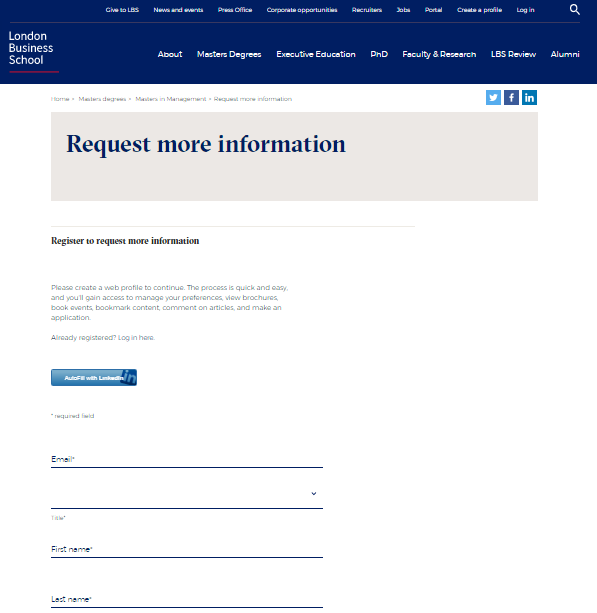
Your landing page forms can be linked to your CRM, with each field assigned an automatic score. Your team can then create smart lists and workflows which prospective students can be automatically added to once they reach a certain score. The end result is a more streamlined, efficient process that ensures leads are communicated with more effectively and appropriately.
Assigning an Initial Score to Prospective Students
When developing a student lead scoring system, it’s important to evaluate prospects on both their level of interest in your school and their suitability for your programs. This means developing a scoring system which accounts for both their demographic characteristics and any interactions they have with your institution.
When looking at demographic factors, it’s best to use your existing student personas as a guideline. Prospective leads with the same characteristics as your main target audience are more likely to become seriously interested in your program, so you should attach scores to things like their age, gender, location, native language, and academic background.
Example: Below is a mock lead scoring table for a language school. As you can see, the higher score is awarded to leads with demographic factors that make them a likely candidate.

Depending on what type of program you are offering, you may wish to consider other, more specific factors too. For instance, professional development courses and postgraduate programs such as MBAs may want to score leads based on their employment experience, industry, or job title.
Example: In order to download a brochure for its MBA program, INSEAD Business School asks prospective students to specify their job title and years of work experience.

Your online inquiry forms are crucial to the student lead scoring process, as they help schools gather in-depth insights from prospective students. Some schools even ask prospects about the motivations or challenges they may face to get a better understanding of their leads.
Example: In their inquiry form, the University of St. Gallen asks prospects ‘Why are you considering an MBA?’ and provides a drop-down menu of common answers to select from. Each of these could potentially be assigned value in a lead scoring system, helping the university to better determine the motivations of potential applicants.

Your inquiry forms can be linked to your CRM system, with each of these actions being given an automatically assigned value and giving every new lead an initial score. From there, your team can examine their profiles, pinpointing high priority leads for more immediate or personalized follow-ups, ensuring your prospective students are segmented correctly, and even disqualifying leads who may not meet the criteria for your programs.
Engagement-Based Student Lead Scoring
The second part of the lead scoring process involves assigning value to any actions prospective students might take during the decision-making process. These can be numerous and vary in how indicative they are of how a lead’s overall interest is progressing. Here are just a few possible actions which might be scorable for your school:
Email engagement – Individual open rates, click-through rates, and unsubscribes can all be monitored and scored through your CRM.
Web browsing behaviour – You can monitor page visits and browsing time on your website and score activities. Actions like downloading brochures and prospectuses tend to be indicative of higher interest and should be weighted more heavily.
Event attendance – If a prospect signs up for an open day, information session, fair, or even an online webinar, it’s a surefire sign they are firming up their interest in your school. Assigning scores to important events like this can be crucial to ensuring you give these leads the personalized attention they need.
Figuring out what value to assign to actions can be confusing, but there are ways to make it clearer. Analyzing your reports in Google Analytics and your CRM will help you figure out which actions are common among prospective students at different stages of the enrollment journey, and what their typical process is before converting.
Example: The All Pages Report in Google Analytics offers a potentially valuable look at which pages prospects are viewing most on your site, while the page value metric in far the right column gives a measure of how much that page might contribute to conversion.
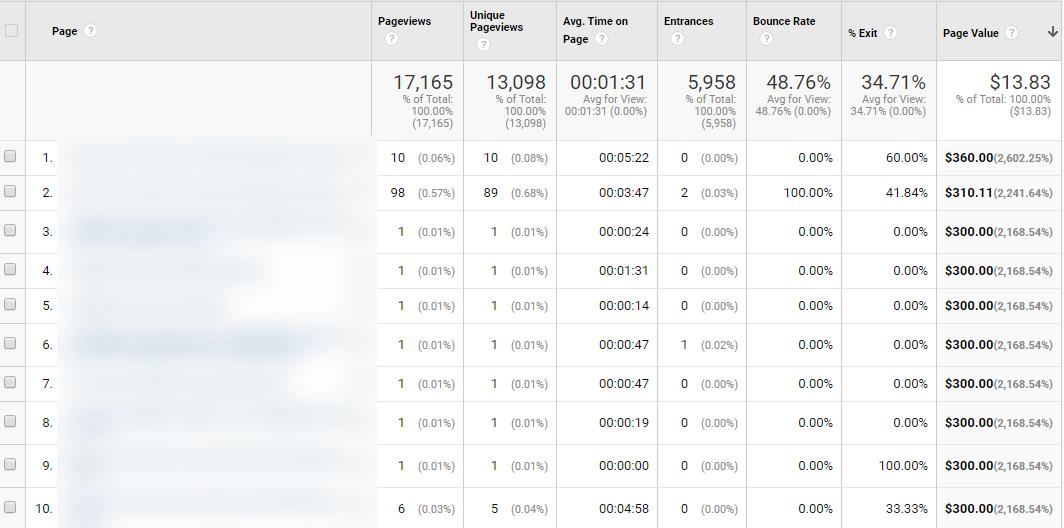
Once you have the proper values in mind, the next step is to implement your lead scoring system in your CRM.
Example: The mautic student lead scoring system enables users to award leads points based on their email engagement. In this instance, 10 points are given to leads who open a particular email.

Make use of your CRM’s customization possibilities to build a lead scoring system that reflects your school’s needs as closely as possible.
How Should You Score Prospective Students?
Lead scoring can be quite subjective, with every school having different parameters. Generally, the simplest approach is to give each lead a score from one to 100, attaching smaller values to each of your criteria. From there, you can set a certain threshold for prospective students to trigger certain follow-up activities, such as phone contact or specific email lead nurturing programs.
Example: A mock-up lead scoring system for a business school.
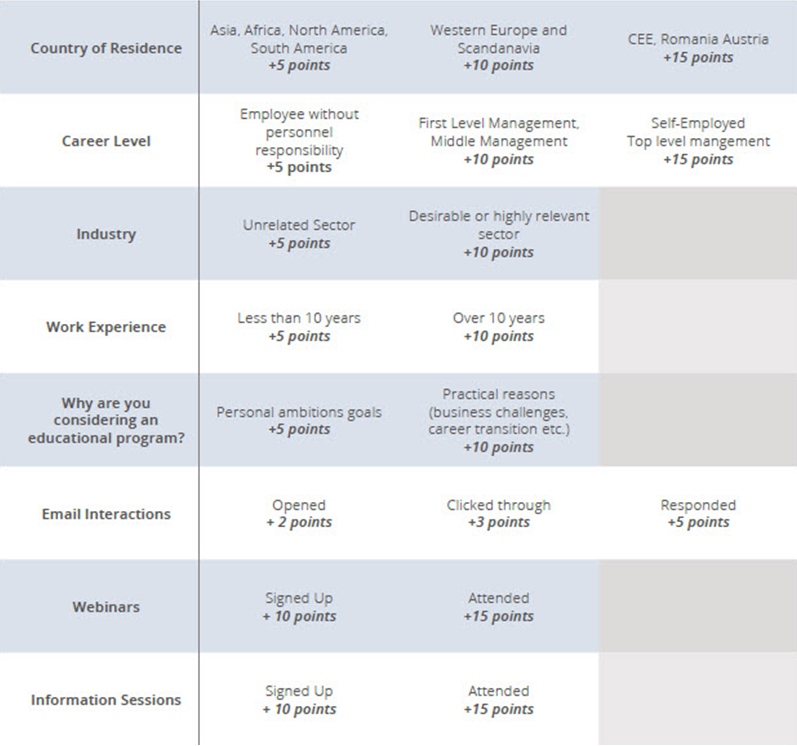
You should also look to include scoring reduction for negative actions like unsubscribing to emails, and scoring degradation so that prospective students who have not engaged with your school for certain periods of time have their score reduced accordingly. This will allow your team to see when the interest of certain applicants is waning and help them decide whether to focus their attention elsewhere or make a more concerted effort to reconnect.
Measuring and Improving the Lead Scoring Process
Once you have a lead scoring model in place, it’s important to monitor and analyze your results to ensure it is as accurate as possible. You may find that you have overestimated the importance of certain factors, or made inaccurate assumptions about your targeted personas. Schools that use the same scoring system for multiple programs also often find they need to refine their criteria, and will sometimes need to create several different scoring models.
Analyzing conversion paths through your CRM and Google Analytics will give you a good idea of what is working and what isn’t, while your admissions team will also provide valuable feedback and will probably be quick to let you know if there is any problem with the leads they are getting.
It’s also important to remember that a prospective student’s lead score is not everything, and it’s important to continue working to reach every possible student. Plenty of high scoring prospects may not follow through on their interest, and many low scoring leads can easily go on to become students if your school works to engage them. Nonetheless, lead scoring can still provide your education lead generation process with more direction and focus, increasing your chances of reaching the right students at the right time.
*This post was originally published in 2018, but has been updated and expanded to reflect the latest trends and developments in the industry.



